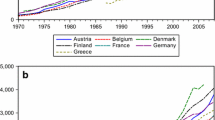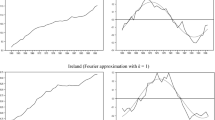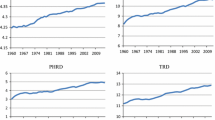Abstract
Due to the lack of internal consistency across unit root and cointegration test methods for short time-series data, past research findings conflict on whether the OECD health expenditure data are stationary. Stationarity reasonably guarantees that the estimated OLS relationship is nonspurious. This paper departs from past investigations that applied asymptotic statistical tests of unit root to insufficient time-series lengths. Instead, data were calibrated in annual growth rates, in 5-year (1968–72, ... , 1993–97) partitions, for maximum likelihood estimation using flexible Box–Cox transformations model and bias-reducing jackknife resampling plan for data expansion. The drivers of OECD health care spending growth are economic and institutional. Findings from the growth convergence theory affirm that health care expenditure growth accords with conditional β convergence. Statistical significance and optimal functional form models are not unique across the growth period models. Our findings exemplify the benefits of jackknife resampling plan for short data series, and caution researchers against imposing faulty functional forms and applying asymptotic statistical methods to short time-series regressions. Policy implications are discussed.
Similar content being viewed by others
References
T. Amemiya, Advanced Econometrics (Harvard University Press, Cambridge, MA, 1985).
A.C. Atkinson, Plots, Transformations and Regression. An Introduction to Graphical Methods of Diagnostic Regression Analysis, Oxford Statistical Science Series, Vol. 1 (Oxford University Press, Oxford, UK, 1985).
S.E. Atkinson and P.W. Wilson, The bias of bootstrapped versus conventional standard errors in the general linear and SUR models, Econometric Theory 8 (1992) 258–275.
R.J. Barro and X. Sala-i-Martin, Economic Growth (McGraw-Hill, Inc., New York, 1995).
P.P. Barros, The black box of health care expenditure growth determinants, Health Economics 7 (1998) 533–544.
W.J. Baumol, Productivity growth, convergence, and welfare: What the long run data show, American Economic Review 76 (1986) 1072–1085.
W.A. Brock and S.N. Durlauf, Growth empirics and reality, World Bank Economic Review 15 (2001) 229–272.
G.E.P. Box and D.R. Cox, An analysis of transformations, Journal of the Royal Statistical Society Series B 26 (1964) 211–243.
R. Butler and E.D. Rothman, Predictive intervals based on reuse of the sample, Journal of the American Statistical Association, Theory and Methods Section 75 (December 1980) 881–889.
R.J. Carroll and D. Ruppert, Transformations and Weighting in Regression Analysis (Chapman and Hall, New York, 1988).
B. Efron, The Jackknife, the Bootstrap and Other Resampling Plans, CBMS-NSF Regional Conference Series in Applied Mathematics, Vol. 38, Sponsored by the Conference Board of The Mathematical Sciences, Supported by National Science Foundation (Printed for the Society for Industrial and Applied Mathematics by J.W. Arrowsmith Ltd., Bristol, England, 1982).
B. Efron and R. Tibshirani, Bootstrap methods for standard errors, confidence intervals, and other measures of statistical accuracy, Statistical Science 1 (1986) 54–77.
B. Efron and R. Tibshirani, Rejoinder, Statistical Science 1 (1986) 77–79.
B. Efron and R. Tibshirani, An Introduction to the Bootstrap (Chapman and Hall, New York, 1993).
U.-G. Gerdtham, Pooling international health expenditure data, Health Economics 1 (1992) 217–231.
U.-G. Gerdtham and B. Jonsson, International comparisons of health expenditure: Theory, data and econometric analysis, in: Handbook of Health Economics, eds. A.J. Culyer and J.P. Newhouse (North-Holland, Amsterdam, 2000).
T. Getzen, Aging and health care expenditures: A comment on Zweifel, Felder and Meiers, Health Economics 10 (2001) 175–177.
W.H. Greene, Econometric Analysis, 3rd Ed. (Prentice Hall, New York, 1993).
P. Hansen and A. King, The determinants of health care expenditure: A cointegration approach, Journal of Health Economics 15 (1996) 127–137.
J.A. Hartigan, Comment, Statistical Science 1 (1986) 75–77.
H. Herwartz and B. Theilen, The determinants of health care expenditure: Testing pooling restrictions in small samples, Health Economics 12 (2003), in press.
P. Klenow, Comment on “It's not factor accumulation: Stylized facts and growth models”, World Bank Economic Review 15 (2001) 221–224.
C. Leger, D. Politis and J. Romano, Bootstrap technology and applications, Technometrics 34 (November 1992) 378–398.
A.N. Link, T.G. Seaks and S. Woodberry, Firm size and R&D spending: Testing for functional forms, Southern Economic Journal 54 (1988) 1027–1032.
G. MacDonald and S. Hopkins, Unit root properties of OECD health care expenditure and GDP data, Health Economics 11 (2002) 371–376.
R.G. Miller, The jackknife-A review, Biometrika 61 (1974) 1–15.
R. Moore, Physics 6730 jackknife error estimates; http://www.physics. utah.edu/~detar/phycs6730/handouts/jackknife/jackknife/node1.htm (accessed October 16, 2003).
N.R.V. Murthy and A.A. Okunade, Managed care, deficit financing, and aggregate health care expenditure in the US: A cointegration analysis, Health Care Management Science 3 (2000) 279–285.
N.R.V. Murthy and I.S. Chen, The empirics of economic growth for OECD countries: Some new findings, Economics Letters 55 (1997) 425–429.
J.P. Newhouse, Medical care costs: How much welfare loss? Journal of Economic Perspectives 6 (1992) 3–21.
OECD, New Directions in Health Policy, Health Policy Studies, No. 7 (Organization for Economic Cooperation and Development, Paris, 1995).
OECD, The Reform of Health Care: A Comparative Analysis of Seven OECD Countries, Health Policy Studies, No. 2 (OECD, Paris, France, 1992).
A. O'Hagan and J. Stevens, Assessing and comparing costs: How robust are the bootstrap and methods based on asymptotic normality? Health Economics 12 (2003) 33–49.
A.A. Okunade and M.C. Karakus, Unit root and cointegration: Timeseries versus panel estimates for international health expenditure models, Applied Economics 33 (2001) 1131–1137.
A.A. Okunade and V.N.R. Murthy, Technology as a 'major driver' of health care costs: A cointegration analysis of the Newhouse conjecture, Journal of Health Economics 21 (2002) 147–159.
A.A. Okunade and C. Suraratdecha, Health care expenditure inertia in the OECD countries: A heterogeneous analysis, Health Care Management Science 3 (2000) 31–42.
A.A. Okunade, Box-Cox vs. Modulus power family of response transformations, Atlantic Economic Journal 19 (1991) 57.
A.A. Okunade, H. Haryanto and D.B. Means, Testing the unbiasedness hypothesis of foreign exchange rates and the analysis of transformations, Review of Quantitative Finance and Accounting 6 (1996) 39–46.
D. Parkin, A. McGuire and B. Yule, Aggregate health expenditures and national income: Is health care a luxury good? Journal of Health Economics 6 (1987) 109–127.
E.A. Peden and M.S. Freeland, Insurance effects of US medical spending, 1960-1993, Health Economics 7 (1998) 671–687.
M.H. Quenouille, Approximate tests of correlation in time-series, Journal of the Royal Statistical Society Series B 11 (1949) 68–84.
M.H. Quenouille, Notes on bias in estimation, Biometrika 43 (1956) 353–360.
J. Roberts, Sensitivity of elasticity estimates for OECD health care spending: Analysis of a dynamic heterogeneous data field, Health Economics 8 (1999) 459–472.
P. Romer, Comment on "It's not factor accumulation: Stylized facts and growth models", World Bank Economic Review 15 (2001) 225–227.
S.K. Sapra, A jackknife maximum likelihood estimator for the probit model, Applied Economics Letters 9 (2002) 73–74.
N. Serup-Hansen, J. Wickstrøm and I.S. Kristiansen, Future health care costs-Do health care costs during the last year of life matter? Health Policy 62 (2002) 161–172.
M. Seshamani and A.M. Gray, A longitudinal study of the effects of age and time to death on hospital costs, Journal of Health Economics (2004), in press.
J.L. Simon and P. Bruce, Resampling: A tool for everyday statistical work, CHANCE. New Directions for Statistics and Computing 4 (1991) 22–32.
P.C. Smith, Measuring health system performance, European Journal of Health Economics 3 (2002) 145–148.
B. Starfield and L. Shi, Policy relevant determinants of health: An international perspective, Health Policy 60 (2002) 201–218.
F.S. Swed and C. Eisenhart, Tables for testing randomness of grouping in a sequence of alternatives, Annals of Mathematical Statistics 14 (1943).
C.G. Tsangarides, On cross-country growth and convergence: Evidence from African and OECD countries, Journal of African Economies 10 (2002) 355–389.
J.W. Tukey, Comparison of some ratio estimators, Journal of the American Statistical Society 60 (1965) 294–307.
M. Veall, Bootstrapping the process of model selection: An econometric example, Journal of Applied Econometrics 7 (1992) 93–99.
H. White, Estimation, Inference, and Specification Analysis (Cambridge University Press, Cambridge, 1994).
C.F.J. Wu, Jackknife, bootstrap and other resampling methods in regression analysis, Annals of Statistics 14 (1986) 1261–1295.
P. Zweifel, S. Felder and M. Meiers, Ageing of population and health care expenditure: A red herring? Health Economics 8 (1999) 485–496.
Author information
Authors and Affiliations
Rights and permissions
About this article
Cite this article
Okunade, A.A., Karakus, M.C. & Okeke, C. Determinants of Health Expenditure Growth of the OECD Countries: Jackknife Resampling Plan Estimates. Health Care Management Science 7, 173–183 (2004). https://doi.org/10.1023/B:HCMS.0000039380.42784.20
Issue Date:
DOI: https://doi.org/10.1023/B:HCMS.0000039380.42784.20




